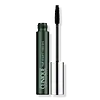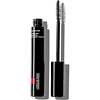What's inside
What's inside
 Key Ingredients
Key Ingredients

 Benefits
Benefits

 Concerns
Concerns

 Ingredients Side-by-side
Ingredients Side-by-side

Water
Skin ConditioningCopernicia Cerifera Wax
Stearic Acid
CleansingGlyceryl Stearate
EmollientPolyisobutene
Silica
AbrasiveAcrylates Copolymer
Aminomethyl Propanediol
BufferingVp/Eicosene Copolymer
Sodium Hyaluronate
HumectantLauroyl Lysine
Skin ConditioningPantethine
EmollientMelanin
Skin ProtectingPanthenol
Skin ConditioningEthylhexylglycerin
Skin ConditioningHydroxyethylcellulose
Emulsion StabilisingCalcium Aluminum Borosilicate
Pvp
Emulsion StabilisingAcacia Senegal Gum
MaskingIsostearic Acid
CleansingSimethicone
EmollientDimethicone PEG-8 Polyacrylate
Urea
BufferingGlycerin
HumectantPentaerythrityl Tetra-Di-T-Butyl Hydroxyhydrocinnamate
AntioxidantSodium Lauryl Sulfate
CleansingPEG-8 Dimethicone
EmulsifyingDisodium EDTA
Sorbic Acid
PreservativeChlorphenesin
AntimicrobialSodium Dehydroacetate
PreservativePhenoxyethanol
PreservativeMica
Cosmetic ColorantCI 77491
Cosmetic ColorantCI 77492
Cosmetic ColorantCI 77499
Cosmetic ColorantCI 77400
Cosmetic ColorantCI 42090
Cosmetic ColorantCI 77891
Cosmetic ColorantCI 19140
Cosmetic ColorantCI 77288
Cosmetic ColorantCI 77289
Cosmetic ColorantCI 75470
Cosmetic ColorantCI 77163
Cosmetic ColorantCI 77007
Cosmetic ColorantCI 77000
Cosmetic ColorantWater, Copernicia Cerifera Wax, Stearic Acid, Glyceryl Stearate, Polyisobutene, Silica, Acrylates Copolymer, Aminomethyl Propanediol, Vp/Eicosene Copolymer, Sodium Hyaluronate, Lauroyl Lysine, Pantethine, Melanin, Panthenol, Ethylhexylglycerin, Hydroxyethylcellulose, Calcium Aluminum Borosilicate, Pvp, Acacia Senegal Gum, Isostearic Acid, Simethicone, Dimethicone PEG-8 Polyacrylate, Urea, Glycerin, Pentaerythrityl Tetra-Di-T-Butyl Hydroxyhydrocinnamate, Sodium Lauryl Sulfate, PEG-8 Dimethicone, Disodium EDTA, Sorbic Acid, Chlorphenesin, Sodium Dehydroacetate, Phenoxyethanol, Mica, CI 77491, CI 77492, CI 77499, CI 77400, CI 42090, CI 77891, CI 19140, CI 77288, CI 77289, CI 75470, CI 77163, CI 77007, CI 77000
Water
Skin ConditioningParaffin
PerfumingCopernicia Cerifera Cera
EmollientSteareth-20
CleansingCera Alba
EmollientAcacia Senegal Gum
MaskingAlcohol Denat.
AntimicrobialSteareth-2
EmulsifyingPotassium Cetyl Phosphate
EmulsifyingCetyl Alcohol
EmollientHydroxyethylcellulose
Emulsion StabilisingMadecassoside
AntioxidantSodium Polymethacrylate
Emulsion StabilisingSodium Dehydroacetate
PreservativeSodium Hyaluronate
HumectantSodium Chloride
MaskingSodium Bicarbonate
AbrasivePhenethyl Alcohol
MaskingPEG/PPG-17/18 Dimethicone
EmulsifyingArginine
MaskingPolysorbate 21
EmulsifyingPoloxamer 188
EmulsifyingPolyquaternium-10
Silica
AbrasiveSimethicone
EmollientPentylene Glycol
Skin ConditioningPanthenol
Skin Conditioning2-Oleamido-1,3-Octadecanediol
Skin ConditioningCaprylyl Glycol
EmollientDisodium EDTA
Methylsilanol/Silicate Crosspolymer
Skin ConditioningCitric Acid
BufferingPotassium Phosphate
BufferingPotassium Chloride
CI 77491
Cosmetic ColorantCI 77492
Cosmetic ColorantCI 77499
Cosmetic ColorantCI 75470
Cosmetic ColorantCI 77007
Cosmetic ColorantCI 77891
Cosmetic ColorantCI 77510
Cosmetic ColorantMica
Cosmetic ColorantWater, Paraffin, Copernicia Cerifera Cera, Steareth-20, Cera Alba, Acacia Senegal Gum, Alcohol Denat., Steareth-2, Potassium Cetyl Phosphate, Cetyl Alcohol, Hydroxyethylcellulose, Madecassoside, Sodium Polymethacrylate, Sodium Dehydroacetate, Sodium Hyaluronate, Sodium Chloride, Sodium Bicarbonate, Phenethyl Alcohol, PEG/PPG-17/18 Dimethicone, Arginine, Polysorbate 21, Poloxamer 188, Polyquaternium-10, Silica, Simethicone, Pentylene Glycol, Panthenol, 2-Oleamido-1,3-Octadecanediol, Caprylyl Glycol, Disodium EDTA, Methylsilanol/Silicate Crosspolymer, Citric Acid, Potassium Phosphate, Potassium Chloride, CI 77491, CI 77492, CI 77499, CI 75470, CI 77007, CI 77891, CI 77510, Mica
Ingredients Explained
These ingredients are found in both products.
Ingredients higher up in an ingredient list are typically present in a larger amount.
Acacia Senegal Gum has skin soothing, thickening, and formulation stabilizing properties. It comes from the Acacia tree that is native to sub-Saharan Africa.
Ci 75470 is a bright-red pigment. It is AKA carmine.
Carmine is derived from insects such as the cochineal beetle. This ingredient has been used as a natural dye for over 2000 years.
This pigment is called Ultramarine blue lazurite. It gives a saturated blue color, but can be used to create other colors as well.
According to the manufacturer, it is usually made from kaolin, sodium sulfate, sodium carbonate, sulfur, and charcoal.
Ci 77491 is also hydrated iron III oxide. It's sole purpose is to give a red/pink hue to products.
Iron III oxides are classified as inorganic chemicals for coloring.
Synthetically created Ci 77491 is considered safer than those naturally found. This is because the synthetically created version may contain less impurities. Iron oxides are generally non-toxic and non-allergenic.
Learn more about CI 77491Ci 77492 is also hydrated iron III oxide. It's sole purpose is to give a yellow hue to products.
Iron III oxides are classified as inorganic chemicals for coloring.
Synthetically created Ci 77492 is considered safer than those naturally found. This is because the synthetically created version may contain less impurities. Iron oxides are generally non-toxic and non-allergenic.
Learn more about CI 77492Ci 77499 is also hydrated iron III oxide. It is created from mixing red and black iron oxides. This helps give shades of darkness to a product.
Iron III oxides are classified as inorganic chemicals for coloring.
Ci 77891 is a white pigment from Titanium dioxide. It is naturally found in minerals such as rutile and ilmenite.
It's main function is to add a white color to cosmetics. It can also be mixed with other colors to create different shades.
Ci 77891 is commonly found in sunscreens due to its ability to block UV rays.
Learn more about CI 77891Disodium EDTA plays a role in making products more stable by aiding other preservatives.
It is a chelating agent, meaning it neutralizes metal ions that may be found in a product.
Disodium EDTA is a salt of edetic acid and is found to be safe in cosmetic ingredients.
Learn more about Disodium EDTAHydroxyethylcellulose is used to improve the texture of products. It is created from a chemical reaction involving ethylene oxide and alkali-cellulose. Cellulose is a sugar found in plant cell walls and help give plants structure.
This ingredient helps stabilize products by preventing ingredients from separating. It can also help thicken the texture of a product.
This ingredient can also be found in pill medicines to help our bodies digest other ingredients.
Learn more about HydroxyethylcelluloseMica is a naturally occurring mineral used to add shimmer and color in cosmetics. It can also help improve the texture of a product or give it an opaque, white/silver color.
Serecite is the name for very fine but ragged grains of mica.
This ingredient is often coated with metal oxides like titanium dioxide. Trace amounts of heavy metals may be found in mica, but these metals are not harmful in our personal products.
Mica has been used since prehistoric times throughout the world. Ancient Egyptian, Indian, Greek, Roman, Aztec, and Chinese civilizations have used mica.
Learn more about MicaPanthenol is a common ingredient that helps hydrate and soothe the skin. It is found naturally in our skin and hair.
There are two forms of panthenol: D and L.
D-panthenol is also known as dexpanthenol. Most cosmetics use dexpanthenol or a mixture of D and L-panthenol.
Panthenol is famous due to its ability to go deeper into the skin's layers. Using this ingredient has numerous pros (and no cons):
Like hyaluronic acid, panthenol is a humectant. Humectants are able to bind and hold large amounts of water to keep skin hydrated.
This ingredient works well for wound healing. It works by increasing tissue in the wound and helps close open wounds.
Once oxidized, panthenol converts to pantothenic acid. Panthothenic acid is found in all living cells.
This ingredient is also referred to as pro-vitamin B5.
Learn more about PanthenolSilica, also known as silicon dioxide, is a naturally occurring mineral. It is used as a fine, spherical, and porous powder in cosmetics.
Though it has exfoliant properties, the function of silica varies depending on the product.
The unique structure of silica enhances the spreadability and adds smoothness, making it a great texture enhancer.
It is also used as an active carrier, emulsifier, and mattifier due to its ability to absorb excess oil.
In some products, tiny microneedles called spicules are made from silica or hydrolyzed sponge. When you rub them in, they lightly polish away dead skin layers and enhance the penetration of active ingredients.
Learn more about SilicaSimethicone is a silicone. It is an emollient and used to reduce foaming in a product. It is also often used to coat sunscreen ingredients for better spreadability.
This ingredient is created by mixing dimethylpolysiloxane and hydrated silica.
This ingredient is a preservative with antimicrobial properties. It is the sodium salt of dehydroacetic acid.
It is especially effective at preventing bacterial and fungal growth in low concentrations.
Sodium Hyaluronate is hyaluronic acid's salt form. It is commonly derived from the sodium salt of hyaluronic acid.
Like hyaluronic acid, it is great at holding water and acts as a humectant. This makes it a great skin hydrating ingredient.
Sodium Hyaluronate is naturally occurring in our bodies and is mostly found in eye fluid and joints.
These are some other common types of Hyaluronic Acid:
Learn more about Sodium HyaluronateWater. It's the most common cosmetic ingredient of all. You'll usually see it at the top of ingredient lists, meaning that it makes up the largest part of the product.
So why is it so popular? Water most often acts as a solvent - this means that it helps dissolve other ingredients into the formulation.
You'll also recognize water as that liquid we all need to stay alive. If you see this, drink a glass of water. Stay hydrated!
Learn more about Water